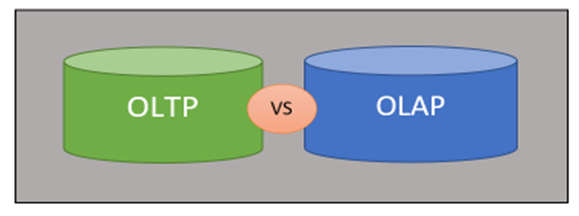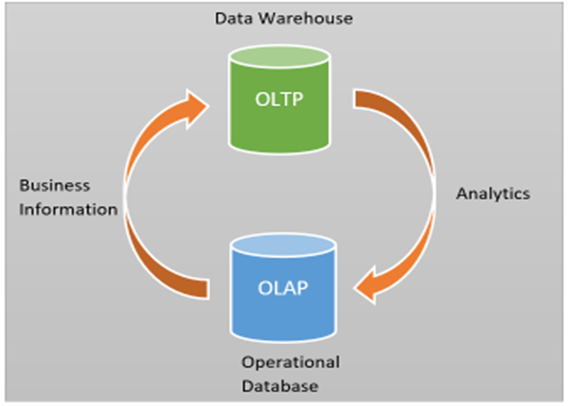This article was published as a part of the Data Science Blogathon.
Introduction
In the field of Data Science main types of online processing systems are Online Transaction Processing (OLTP) and Online Analytical Processing (OLAP), which are used in most companies for transaction-oriented applications and analytical work. In the Database Management System, both OLAP and OLTP
play an important role. In this article, we have highlighted the key differences between OLTP and OLAP that will help you learn how to distinguish between the two.

OLTP
OLTP stands for Online Transaction Processing. It deals with transaction-related operations such as query processing, data integrity, efficiency, and effectiveness. Relational databases serve as the organized and detailed source for Online Transaction Processing. The atomicity of the OLTP system ensures that either the transaction succeeds completely, or the transaction is completely canceled, thus maintaining transaction integrity. Since OLTP queries are simple and straightforward (insert, update, delete), they require little time in processing, and they also take up less space. In order to maintain data integrity, OLTP needs frequent incremental backups. It is a market-driven system that includes applications such as online banking, ticket booking, storing information, etc. Furthermore, it assists in managing the day-to-day transaction-oriented operations of an organization. Due to the timely modification of all transactions, OLTP provides a solid foundation for a stable business.
OLAP
OLAP stands for Online Analytical Processing and is used to handle data analysis and retrieval. It is a customer-driven data analysis system that helps organizations make more informed decisions by analyzing business data. OLAP is based on a data warehouse method and uses complicated queries to find insights and solve specific business problems. In OLAP, multidimensional data can be analyzed logically and effectively by using OLAP cubes which store and analyze multidimensional data in an orderly fashion. It is a powerful technology for discovering data. This system makes sure data is secure by implementing
appropriate security measures. It is commonly used for financial reporting tools,
and forecasting as well as for business intelligence tools and data mining.
Advantages and Disadvantages of OLTP
The advantages and disadvantages of the OLTP system are as follows:
Advantages:
- With an OLTP system, you can process more transactions per second than with other systems and have faster response times.
-
Online transaction processing systems are
available around the clock, increasing their accessibility. -
It is relatively easy to achieve low processing
times on OLTP systems since queries are pretty simple and
space-efficient. -
With OLTP systems, Atomicity protects the integrity of online transactions with credit cards or other payment methods.
Disadvantages:
- In OLTP systems, multiple users can access and update the same data at once, resulting in unusual circumstances.
- To maintain inventory, OLTP requires many workers to work in groups, resulting in high staff dependence
- An OLTP system that fails due to hardware issues will severely impact online transactions.
- In OLTP System, the number of queries is limited.
- There is a huge risk of data loss if the server goes down, which affects a large number of online transactions.
Advantages and Disadvantages of OLAP
The advantages and disadvantages of the OLAP system are as follows:
Advantages:
-
OLAP allows multi-dimensional display and analysis of data.
-
OLAP systems do not alter transactional data.
- Data processing is fast using OLAP.
- It ensures data confidentiality by implementing appropriate security measures.
-
A faster response to market needs is enabled by it.
Disadvantages:
- As traditional tools in this system require a complicated modelling approach, business users continue to depend on IT professionals.
- As OLAP systems have high costs, they are not as easily implemented as they should be.
- Any changes to an OLAP cube require updating the entire cube and requires IT skills and takes a long time.
- Due to the high demands of business users, OLAP systems may be slow to respond.
- Analyzing OLAP data may require advanced skills.
Difference between OLTP and OLAP

The differences between OLTP and OLAP are as follows:
| OLTP | OLAP | |
| 1. | OLTP is an acronym for Online Transaction Processing and handles large numbers of online transactions and database modifications. |
OLAP is an acronym for Online Analytical Processing, which performs data analysis and retrieval tasks. |
| 2. | OLTP is based on traditional DBMS methods and handles operations like insert, delete, and update. | OLAP is based on the data warehouse method and extracts data for analysis. |
| 3. | OLTP uses relational databases(eg. DBMS) as their organized and detailed source. | In OLAP, the OLTP database can be used as the source, and data in OLAP may not be organized. |
| 4. | In OLTP databases, table columns must be normalized using 3NF |
In OLAP tables may or may not be normalized. |
| 5. | OLTP uses simple and straightforward queries, so it is quick and requires only a few milliseconds to complete. | OLAP uses complex queries that are slow and require a lot of processing time |
| 6. | OLTP databases use an application-oriented design | OLAP databases use subject-oriented design |
| 7. | To maintain data integrity, OLTP requires frequent and incremental backups. | OLAP requires less frequent backups, i.e. every so often. |
| 8. | OLTP system is a market-driven system for real-time business operations |
OLAP is a customer-driven system to analyze business data and make better decisions |
Conclusion
We have discussed both the online processing methods in this article, i.e., online transaction processing (OLTP) and online analytical processing (OLAP). Moreover, we discussed their advantages and disadvantages and how they can be differentiated. The use of online processing systems simplifies business operations. Here are a few key takeaways from this article:
- The OLTP platform processes and manipulates a large number of online transactions, while the OLAP platform handles analytical tasks and retrieves data.
- OLTP is based on traditional DBMS methods and OLAP is based on the data warehouse method.
- Online transaction processing is used by online banks, ticket booking services, etc., and provides a solid foundation for a stable business.
- OLAP can be used for financial reporting, forecasting, business intelligence, and data mining because of its flexibility.
- For OLTP databases, table columns must be normalized, whereas OLAP tables do better if not normalized.
Hopefully, you now have a better understanding of what Online processing systems are and how they differ.
The media shown in this article is not owned by Analytics Vidhya and is used at the Author’s discretion.





